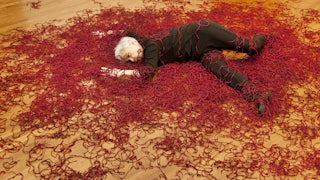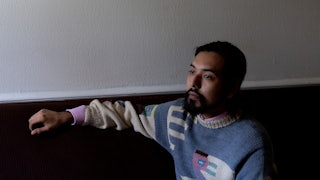It didn’t get a lot of attention, but back in November, a candidate representing one of the country’s most successful homegrown fascist movements got a little over 25,000 votes in her bid for Chuck Schumer’s Senate seat. This was Diane Sare, who, in a campaign video taken outside Federal Hall on Wall Street, named as her main qualification her “32-year association with the greatest economist and statesman the United States has yet produced, the late Lyndon H. LaRouche Jr.” The way she delivered the line, positioned as she was beneath the bronze crotch of George Washington, speaking with the dead-eyed adamancy of someone well practiced in the arts of political irritation, it was a little as if she were daring you to laugh.
And how could you not, just a little? A LaRouchie on the ballot! In the third decade of the twenty-first century! Yesterday’s cranks, still doing their thing in the age of Q, their thing being, in part, to shriek in the middle of town halls, hector people from their little stands in public parks, put Hitler mustaches on photos of President Barack Obama, declaim against the queen of England for having been the most prolific drug dealer this side and probably that side of Pablo Escobar, and continue carrying the torch for the once-ubiquitous paranoid gadfly candidate to end all gadfly candidates. LaRouchies still walk among us, embarrassing undead artifacts of another era’s grotesque folly, like Henry Kissinger or the Bay City Rollers. God love ’em, you almost want to say.
Sare brought home half a percent of the vote; she was routed by blank ballots. But winning elections was never really the point for the LaRouchies, even in their heyday, and elsewhere this fall, there were signs that LaRouchism was having a small moment.
Here was Sare, swinging at softballs from the post-left YouTube screamer Jimmy Dore. There were her staffers and compatriots, heckling Alexandria Ocasio-Cortez and lambasting Ilhan Omar, among others, over their votes to send military aid to Ukraine. Allowing themselves to be styled in the press as disillusioned anti-war leftists, they rope-a-doped AOC and Omar into denouncing them as Russian stooges. For a moment, the Squad members were left looking like evasive, hippie-punching warmongers by a group that made its bones in the 1970s attacking leftists with nunchucks (not kidding—literal nunchucks).
Four years ago, the Grand Poo-Bah went to that great airport table in the sky. LaRouche was invariably described in obits as a cultist and an eccentric—indeed, he was a wackadoo perennial presidential candidate who kept saying weird stuff about the Rockefellers. But from the vantage of the present, LaRouche doesn’t seem so out of step with the country’s politics. And the diminishment of his group over the past couple of decades—in the 1980s, LaRouchies raised hundreds of millions of dollars and even won a couple of primaries, all while maintaining a massive private intelligence operation and insinuating themselves in the Reagan administration by promoting the Gipper’s Star Wars program—doesn’t look like marginalization anymore so much as reabsorption.
Reading the past few years of American politics backward into the history of LaRouchism, the movement comes off more and more like a baroque and churlish expression of a tendency that’s general across our politics, right and left, fringe and normie alike. Laugh at Diane Sare if you wish, but how freakish is a LaRouchie, really, in 2023?
LaRouche was born into his conspiracism. His parents were orthodox Quakers in New England, but these were not the serenely tolerant Quakers of popular image. In his definitive Lyndon LaRouche and the New American Fascism, Dennis King reports that the couple “were ferocious sectarians who accused their co-religionists of closet Bolshevism and embezzlement of religious funds.” In a way, it was the organizing conceit of his life: the war on the enemy within.
A self-described “hardened Trotskyist,” he was a member from 1948 to 1963 of the Socialist Workers Party, a group that was red-baited and factionalized into oblivion, after which he stayed hardened but let the Trotskyism slide. In 1968, he led a group within Students for a Democratic Society that broke with the larger organization over the pivotal Ocean Hill-Brownsville teachers’ strike in New York City. The strike pitted Black and Puerto Rican parents pushing for community control against white educators. LaRouche’s group took the teachers’ side—a sort of paleo–anti-wokeness that feels a little less paleo when you see the strike signs. “STOP TEACHING RACE HATRED TO CHILDREN,” one read.
Drummed out of SDS, the faction rechristened itself the National Caucus of Labor Committees, a name that seemed designed to roll off the tongue like a metal file drawer, perhaps deliberate in its blandness. Things got fashy in short order. In 1973–74, the NCLC launched Operation Mop Up, a campaign of ferocious assaults on rival leftists, particularly members of the Communist Party USA, while internally the group was increasingly run like a cult, with LaRouche using abusive “ego-stripping” sessions to firm up his followers’ ideological commitments. Partnerships of convenience were struck with right-wing groups; racism and antisemitism flowered, for reasons both ideological and instrumental. “He is a racist, unconsciously to be true,” wrote no less an authority than Robert Miles, a Ku Klux Klan leader, exulting in his newsletter after a couple of LaRouchies won Democratic primaries in Illinois in 1986. “His glorification of European culture, morals and histories is instinctive.” At the same time, LaRouche used the inadequacies of liberal antiracism to recruit from the growing ranks of thwarted Black nationalists. This wasn’t lost on Miles, either: “He mixes his forces, having blacks and Jews in his ranks. But then, so did every conquering army in history.”
Analysis of the LaRouche movement, when it’s taken seriously, tends to focus on the drift from left to right, from the Marxist-Leninism of his New Left days in the 1960s to reactionary conspiratorial populism from the 1970s. But as the writer Donald Parkinson has observed in the online magazine Cosmonaut—as always, it’s the communists who see LaRouche most clearly, at least when they’re not getting their heads cracked open—there were continuities that spanned LaRouche’s different eras. There was the egomania, which manifested in a One True System mode of thinking, and an economism so stubborn and one-eyed it could only conceive of the Holocaust as a policy of labor exploitation.
But above all, there was LaRouche’s belief in an essentialized, even biologized, unassimilable Other. This Other stalks the thickets of his prose in the form of “the Aristotelians,” “the Rothschilds,” “the witches,” “the oligarchs,” and it would come to sit comfortably alongside his producerist view of finance capital as a parasite thrusting itself on to the “real” economy—a great vampire squid wrapped around the face of humanity, to borrow Matt Taibbi’s famous metaphor for Goldman Sachs. (Think the hysteria about “woke capital” is anything new? Check out LaRouche’s argument about the credit system smoothing its expansion into the global south via “bourgeois-democratic revolution.”) Whatever leftist airs it might have once assumed, LaRouche’s was a fascist logic for what could only become a fascist politics.
Bear in mind that LaRouche was recruiting at a time of rapid deindustrialization and financialization across the United States; worker power was being crushed. Conspiracy provided the language for his narrative about the dastardly enervation of the proletariat, just as QAnon’s lurid phantasmagoria offered a grammar by which people could understand what they saw as threats to the family and gender order.
To dismiss LaRouchism or Q as pure irrationality is to ignore the political stories they were telling, the way they enlisted people in counterrevolutionary projects. King makes the persuasive case that all that business about the queen was antisemitic code—in LaRouche’s view, Jewish high finance had so thoroughly subsumed the British Empire that the two were basically synonymous. Whenever he called Queen Elizabeth a drug pusher, everyone would have a laugh, but he was really talking about getting rid of the Jews.
In 1988, LaRouche was convicted of mail fraud and tax evasion. His incarceration marked the beginning of his group’s decline. Into the new century, it did retain its ability to annoy, staging racist demonstrations after the election of the first Black president and rallying support for the white nationalist who succeeded him. Last year, a schism opened up between the Lyndon LaRouche PAC and the LaRouche Organization—run by his widow—in part because the former had been too favorable to Donald Trump.
“Narcissism of small differences” and all that, but you could maybe understand the LaRouche Organization’s wish to carve out a distinction. Trump and LaRouche may have shared a makers-and-takers conspiracism with roots going back to the country’s founding, but it was LaRouche who put Jefferson in a brownshirt, LaRouche who first articulated a Euro-style fascism in a cosmopolitan American idiom—fascism without the umlauts or the hoods.
Sare was not the only LaRouchie on the ballot last cycle, incidentally. In New Mexico, Solomon Peña ran for the state House as a Republican. He lost, and later it emerged that he’d given more than $5,000 to LaRouche PAC since 2021. In denial about his defeat, Peña was arrested in January after he allegedly paid four men to shoot at the homes of Democratic leaders around Albuquerque. Nobody was hurt, but the shootings had their intended effect: fear. The 10-year-old daughter of a state senator was awakened by what she thought was a spider on her face. It turned out to be drywall dust from the holes opened up by the bullets. No one seemed to be laughing.


